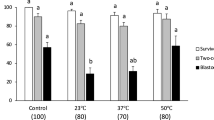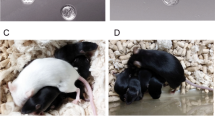Abstract
The following three methods were evaluated in order to obtain a most efficient freezing protocol for the preservation of two-cell mouse embryos: (a) slow cooling and slow thawing in 1.5M dimethyl sulfoxide, (b) slow cooling and fast thawing in 1.5M propanediol (PROH), and (c) ultrarapid freezing and fast thawing in either 3.5M DMSO or 3.0M PROH. In the slow-cooling procedures (a and b) ice nucleation (seeding) was induced manually or automatically. With method a, only a slight difference, 51.8% for manual and 58.9% for automatic seeding, was observed in survival rates, while the development to blastocysts was significantly affected: 35.4% with manual and less than 10% with automatic induction (P<0.001). Method b gave high survival (86.2%) and developmental rates (69.0%) with manual seeding compared with automatic seeding (20.7 and 9.8%, respectively;P<0.001). Using protocol c, higher survival and developmental rates were obtained with DMSO (84.8 and 55.9%) than with PROH (39.8 and 19.4%,P<0.001). These results demonstrate that inducing nucleation manually is superior to the use of a highly sophisticated autoseeding system and that method b with manual seeding is most effective in preserving the developmental capacity of twocell mouse embryos after freezing and thawing. There is evidence that this is also true of human embryo cryopreservation.
Similar content being viewed by others
References
Trounson A, Mohr L: Human pregnancy following cryopreservation, thawing and transfer of an eight-cell embryo. Nature 1983;305:707–709
Cohen J, Simons RS, Fehilly CB, Edwards RB: Factors affecting survival and implantation of cryopreserved human embryos. J Vitro Fert Embryo Transfer 1986;3:645–651
Lassalle B, Testart J, Renard JP: Human embryo features that influence the success of cryopreservation with the use of 1,2 propanediol. Fertil Steril 1985;44:645–651
Testart J, Lassalle B, Forman R, Gazengel A, Belaisch-Allart J, Hazout A, Rainhorn JD, Frydman R: Factors influencing the success rate of human embryo freezing in an in vitro fertilization and embryo transfer program. Fertil Steril 1986;48:107–112
Cohen J, De Vane GW, Elsner CW, Kort HI, Massey JB, Norbury SE: Cryopreserved zygotes and embryos and endocrinologic factors in the replacement cycles. Fertil Steril 1988;50:61–67
Trounson A, Peura A, Kirby C: Ultrarapid freezing: A new low-cost and effective method of embryo cryopreservation. Fertil Steril 1987;48:843–850
Trounson A, Peura A, Freemann L, Kirby C: Ultrarapic freezing of early cleavage stage human embryos and eightcell mouse embryos. Fertil Steril 1988;49:822–826
Wilson L, Quinn P: Development of mouse embryos cryopreserved by an ultra-rapid method of freezing. Hum Reprod 1989;4:86–90
Trounson A: Preservation of human eggs and embryos. Fertil Steril 1986;46:1–12
Whittinham DG: Some factors affecting embryo storage in laboratory animals.In The Freezing of Mammalian Embryos: CIBA Foundation Symposium 52, K Elliet, J Whelan (eds). Amsterdam, Elsevier, 1977, pp 97–108
Miyamoto H, Ishibashi T: Effects of the temperature of iceseeding on survival of frozen-and-thawed mouse morulae. Experientia 1981;37:187–188
Mandelbaum J, Junca AM, Plachot M, Alnot MO, Salat-Baroux J, Alvares S, Cohen J: Outcome of assisted procreation: Role of the embryo freezing. Presented at II joint ESCO-ESHRE meeting, Milan, Aug. 29–Sept. 1, 1990, ESHRE, 1990, p 35
Schneider V: Cryobiological principles of embryo freezing. J Vitro Fert Embryo Transfer 1986;3:3–9
Renard JP, Bui-Xuan-Nguyen, Gainier V: Two-step freezing of two-cell rabbit embryos after partial dehydration at room temperature. J Reprod Fertil 1984;71:573–580
Van der Auwera I, Cornille F, Ongkowidjojo R, Pijnenborg R, Koninckx R: Cryopreservation of pronucleate mouse ova: slow versus ultrarapid freezing. Hum Reprod 1990;5:619–621
Surrey ES, Quinn PJ: Successful ultrarapid freezing of unfertilized oocytes. J Vitro Fert Embryo Transfer 1990;7:262–266
Author information
Authors and Affiliations
Rights and permissions
About this article
Cite this article
Macas, E., Xie, M., Keller, P.J. et al. Developmental capacities of two-cell mouse embryos frozen by three methods. J Assist Reprod Genet 8, 208–212 (1991). https://doi.org/10.1007/BF01130806
Received:
Accepted:
Issue Date:
DOI: https://doi.org/10.1007/BF01130806




